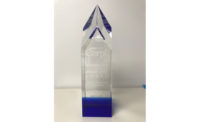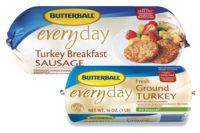In 2010, deli meats recorded sales of around $4.5 billion in the food channel, excluding Walmart, reports the Perishables Group, Chicago. Last year, deli meat, including pre-sliced meats, posted dollar sales up 4 percent and volume that was relatively flat with a 0.4 percent increase, the research firm says. Pre-sliced meat grew 9 percent in both dollar sales and volume last year, which is where a substantial amount of the gains were derived, says Jonna Parker, Perishables Group’s account services director.
In terms of pre-sliced meat versus bulk meat sales in the deli food channel, excluding Walmart, 88 percent of all dollars sold in the deli come from bulk, the Perishables Group reports. Bulk meat’s dollar share is down slightly, 0.3 percent, which was gained by deli pre-sliced meat.
Supermarket delis are gaining share of the food channel’s perishables sales, driven by deli prepared foods, the Perishables Group reports. In 2010, the supermarket deli led all fresh departments, including produce and bakery departments, in sales growth, increasing both dollar and volume sales by 4.5 percent. According to the research group’s Deli Department Drivers report, 94 percent of consumers purchased from supermarket delis last year and nearly one-third of those purchases contained multiple deli items. This rate of multiple purchases was higher than any other fresh department except produce, the Perishables Group says.
Deli entrees and deli-prepared chicken both increased dollar and volume sales by double-digits, the research firm says. The report also attributes a portion of the supermarket deli’s success to the growing assortment that better meets the needs of a diverse consumer base. For example, new ethnic and spicy flavors drove gains in deli meat. In addition, the number of low-sodium deli meat items grew by 22 percent in the past year, catering to a more health-conscious demographic, Perishables Group says.
Of the whole supermarket deli, meat holds about 26.5 percent of weekly sales and about 22.9 percent of adjusted gross profit, according to Barrington, Ill.-based market research firm Willard Bishop’s Total Store SuperStudy data. By comparison, prepared foods represent about 31.8 percent of weekly deli sales and about 15.3 percent of adjusted gross profit. Through the deli, supermarkets are selling approximately $10,164 each week of meat and about $12,192 each week of prepared foods, Willard Bishop data shows.
While supermarket deli lunchmeat grew by 2.1 percent between 2009 and 2010, it showed 6 percent gains between 2007 and 2010, indicating that consumers are willing to pay more for perceived higher quality and freshness even in an economic recession, according to Chicago-based Mintel International’s May 2011 Lunch Meat report. Mintel forecasts that the segment will post consistent annual growth between 2011 and 2015, with potential to push the segment past the $5 billion mark in 2015.
A fresh appeal
The deli can help fulfill a number of people’s different dining needs. Yet, in the supermarket deli, turkey breast and ham are still the top two sellers and make up about one-third of deli sales, the Perishables Group reports.
“In our market insights data, both ham and turkey have heavy penetration, and some shoppers might even switch in between ham and turkey depending what’s on sale,” Parker says. “It’s about flavor and about brand variety.”
Following next in sales is beef, which posted better numbers after years of decline, Parker says. While chicken is a small market compared to ham and turkey, the protein is growing in double-digits, she says.
International Dairy-Deli-Bakery Association (IDDBA) research has shown that shoppers find the deli appealing because they see it as fresh and convenient.
Research in Mintel’s May 2011 Lunch Meat report, confirms consumers’ desires for freshness. More than two-thirds of respondents to Mintel’s consumer survey of people who eat lunchmeat indicate that deli counter lunchmeat is fresher and claim they can tell a difference in taste between deli counter and prepackaged lunchmeat.
“It’s the freshness and the difference in taste that I think is what is attracting them,” says Carla Chastain, a senior food analyst at Mintel. “Additionally to that, about half of respondents are willing to pay more for a product that they consider premium.”
On the whole, the deli has some very strong equities with consumers in terms of product quality and freshness.
“The grab-and-go items, whether hot or cold, provide quick, convenient meal solutions,” says Worth Sparkman, manager of public relations at Tyson Foods Inc. “One benefit that a deli convenience meal has over, say, a visit to a quick-service restaurant, is that it becomes the centerpiece of a fill-in shopping trip where the shopper picks up other items that they need without making an additional stop.”
Customization also is essential for many shoppers, says Kari Lindell, director of retail marketing at Butterball LLC.
“Consumers shop the deli for fresh, high-quality meat options that will be sliced upon ordering,” she explains. “Slicing at the point of ordering ensures meat is as fresh as possible, plus it enables customization of slice thickness based on the customer’s usage or preference.
“Furthermore, the deli offers a vast variety of flavors,” she continues. “Again, this is a great way to customize meals to individuals in your family. Children tend to prefer mainstream flavors such as Oven Roasted or Honey, whereas adults may have a palette that seeks more intense flavors such as Cajun, Deep Fried Buffalo or Lemon Pepper — all of which are delicious for sandwiches or recipes.”
The prepackaged deli case also offers consumers freshness and convenience with no standing in line, says Tom Lopez, director of marketing at Kraft Foods for Oscar Mayer.
“In addition, it offers consumers variety in meats, flavors and package size,” he says.
Overall, consumers continue to look for foods they like to eat and feel good about serving.
Paula Shikany, director of Sara Lee Deli, says it’s important to deliver foods that provide a balance of quality, taste and nutrition, which adds to the appeal of the deli case.
“Additionally, consumers consider sliced-to-order meats to be of the highest quality and freshest options available, which continues to drive its appeal,” she says.
Cost is key
The biggest factor that would make shoppers purchase more from the deli is price, says Alan Hiebert, IDDBA’s education information specialist.
“Price still trumps freshness, convenience and even taste,” he says. “A few deli shoppers would like to see more variety in the departments they shop, but it’s a significantly smaller group than the shoppers who’d like to see lower prices or more sales and specials.”
Nearly two-thirds of consumers surveyed for IDDBA’s Consumers in the Deli 2010 research admit to monitoring their purchases more closely, and 65 percent are buying fewer items on impulse — down from 75 percent in 2009. Sixty-four percent of consumers said they’re paying extra attention to advertised prices, down from 73 percent in 2009. Sixty-three percent say they stick to a shopping list, and 54 percent are using coupons more often. Forty-five percent of consumers said they bought the same amount from their supermarket deli in 2010 compared to 2008, IDDBA’s report found. But the percentage who said they bought less has increased significantly since 2004 — from 23 percent to 34 percent, the association says.
Delis are bridging the gap between dining out and dining in as time-strapped shoppers stay away from higher restaurant prices but still want high-quality, easy-to-assemble meals. Forty percent of shoppers said they eat sliced-to-order deli meats once or more a week, indicating that they’re packing more sandwiches for lunch to minimize food costs, according to IDDBA’s Consumers in the Deli 2010.
In addition, the deli prepared food category’s share has grown to more than 50 percent in the last five years, while deli meat shares have gradually declined to around 24 percent, IDDBA says. Versatile rotisserie meats such as chicken have been flying out of the deli as part of the dining-in trend, the association says. These meats can be eaten as they are, as well as in leftovers, sandwiches, salads and soups — a benefit to time-stressed consumers.
Pricing concerns in the deli are the same trends affecting purchasing of most food items in the store.
“Everybody is concerned about the effects of food price inflation,” says Jim Hertel, managing partner at Willard Bishop. In turn, most shoppers are trading to the deli from other channels, he says. But in other efforts to save money, some consumers may trade down to purchasing deli items less frequently or trading to a store without a service deli.
“Sharp retailers are going to be thinking in terms of highlighting what the value offerings are, maybe thinking about delivering equivalent quality and look for ways that they can save as a retailer and pass those savings on to shoppers,” Hertel says. “… The challenge that they are going to face over the rest of the year is what happens to costs, their costs, and how can they leverage the deli strengths in terms of maintaining shopper loyalty without making an incremental shopper investment. Managing costs and maintaining shopper loyalty in a very challenging economic environment is going to be the name of the game.”
In 2010, deli suppliers were able to keep price increases relatively minor and flat for the majority of the year, especially in deli meat and cheese, the Perishables Group’s Parker says. But toward the end of last year and beginning of 2011, costs began to be passed along to the consumer. For example, deli bulk meat is up an average retail price of about 5 percent for the 52 weeks ending April 30, 2011, verses being flat in 2010, she says.
“A lot of that increase is happening right here, now in the most recent weeks of 2011,” Parker says. “A lot of [it comes] in a lower percent discount when on promotion. We’re still seeing the same frequency of promotion, but we are seeing less of a discount being offered to that consumer.”
Private-label deli meats, the largest portion of deli bulk meat sales nationally, are flat when it comes to pounds sold and up slightly in dollar sales for the year ending April 30, Perishables Group reports.
“The average retail price on private- label deli meats is actually a little bit higher on average on a national perspective,” Parker says. “But what happened with private label over the last five years, even in the last three or so since the recession, is that retailers are coming out with a two-tiered or multi-tiered private-label pricing program in deli meat and deli cheese, so offering a premium-type, exclusive corporate brand product in addition to more of that generic-type product in private label. While there is price increase and it’s a little more market in private label, some of that is still the switch to having a higher-quality private-label item.”
Healthier shoppers
While no typical deli shopper exists, respondents to IDDBA surveys tend to be worried about their health and how their diets affect their health.
“A majority of respondents said they or someone in their households were making serious efforts to decrease fat, calories, trans-fat, sugar, sodium or carbohydrates,” Hiebert says.
From 21 to 29 percent of people who eat deli and prepackaged lunchmeat indicated, in a Mintel consumer survey, that they seek out some type of health claim for their meat purchases at least some of the time. About half of consumers surveyed agree that they have purchased in the past three months low-sodium or sodium-free deli and prepackaged lunchmeat all, most or some of the time. About 56 percent of consumers polled also agreed to selecting natural deli and prepackaged lunchmeat all, most or some of the time in the past three months.
Nearly half of consumers also reported buying low-calorie deli and prepackaged lunchmeat all or most of the time in the past three months, Mintel says. Low-fat purchases also were popular with about 55 percent of consumers saying they select this option of deli and prepackaged lunchmeat all, most or some of the time in the past three months. About 35 percent of respondents indicated purchasing American Heart Association endorsed deli and prepackaged lunchmeat all, most or some of the time in the past three months.
“There’s a lot of talk right now about healthy eating,” Tyson’s Sparkman says. “Different areas of the deli are shopped by different consumer segments, and health claims are typically more important in the cold service case and the cold self-serve case.”
The biggest trend the Perishables Group’s Parker sees in deli meat sales is the rise in low-sodium products. Most retailers are now carrying a low-sodium line and expanding their low-sodium bulk and pre-sliced offerings as just part of their everyday deli case offerings.
“We’re seeing brands reinvented because of low sodium, like Sara Lee, that have really performed very well in the last year or two with their low-sodium line,” Parker says. “… Low sodium is also a product that has allowed people to feel better about their deli meat purchases, and maybe even sodium was always the scary thing of deli meats. People were afraid of how much sodium it had in it. Now with low-sodium offerings, it allows them to keep eating deli meats and not be as worried.”
“Anything that a deli product overall, especially meats and cheeses, can do to make the consumer feel good about the ingredients and a limited number of ingredients going in is a good thing,” Parker adds.











Report Abusive Comment